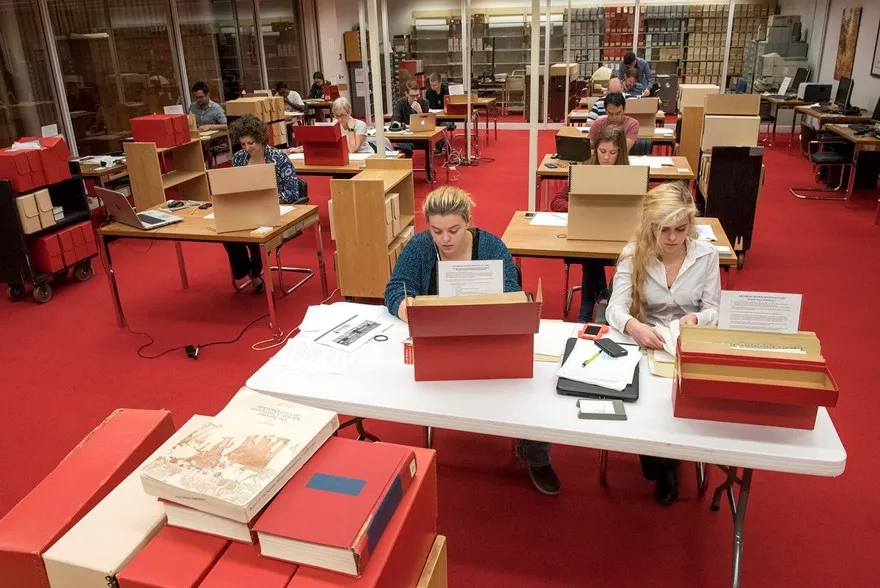Jump to: DiscoverLBJ item fields
A-Z archival and DiscoverLBJ terms
- archives, archivists
- arrangement
- audiovisual (AV)
- available
- Bio Sketch
- box
- closed, closure
- collection
- Digital Item
- finding aid
- folder
- Folder title list
- guide (see: subject guide)
- item description
- List of Holdings
- open (see: available)
- original order
- partially available
- pink sheet (see: withdrawal sheet)
- processing
- provenance
- Reading Room
- Reference Material
- records
- sanitize, sanitization
- series
- subject guide
- textual
- withdrawal sheet
LBJ Library archival terms
Records, boxes, and folders
Archives contain records, and archivists review, preserve, describe, and make records available for researchers. The LBJ Library is run by the National Archives and Records Administration (about). NARA archivists care for the records in the Library's holdings (four floors of our building in Austin, TX).
The red boxes visible from the LBJ Library museum Great Hall contain original records, which relate to President Lyndon B. Johnson.
Records are documents–or photos, films, recordings, computer files, etc.–created or maintained by a person or organization in the course of day-to-day business that are no longer in use and are worthy of preservation.
Most of the LBJ Library's records came from the Johnson White House, 1963-1969. They were not created on computers. The archives has paper organized in file folders; motion picture film and videotape; audio tape and dictabelts; and photographic prints and negatives. Learn more about LBJ White House records here.

Boxes have unique numbers within each collection. The LBJ Library archives contain about 45 million pages in 50,000+ boxes, so archivists work with researchers to identify which specific boxes in which collections they want to see.
Boxes contain folders of documents, and each folder has a title printed or written on the tab that describes its contents. These folder titles are compiled into lists that tell researchers what each box in each collection or series contains. Our folders average around 120 pages but this varies considerably from collection to collection.
Researchers review boxes and folders one by one in the LBJ Library Reading Room, a monitored room of desks where researchers request carts of boxes that they read through at their own pace.

Collections and series
Archival collections at the LBJ Library are usually groups of material from a single creator, which can be a person or organization. Creators are often but not always the same as collection donors. Archivists maintain these groupings and do not combine collections.
Collections can be anywhere from one item to hundreds of boxes. They may be textual (paper-based) or audiovisual (photos, audio, film, and video). At the LBJ Library these are different departments. There are more than 500 collections total.
Collections contain series, or sub-collections, which might have names like Subject Files or Name Files depending on how they were organized when in use. A series is a group of material that is related by record format, function, or creation. A collection may have one or many series, and each level of description is inherited to the next. Every record belongs to exactly one collection and one series.
Folder title lists
Folder title lists (sometimes called finding aids) describe the contents of the boxes in a collection so researchers know which to request in the Reading Room. LBJ Library folder title lists include box numbers and folder names, usually accompanied by collection and/or series descriptions that identify the collection's date range, types of documents, important names, subjects, etc. found within the collection.
Folder titles are how office staff found documents quickly. They are crucial to archival research because they usually originate with the archival creators (not archivists later on) and they denote the smallest, most specific groupings of material. They also often contain clues that may not be obvious from the documents themselves: an invitation could be filed in Invitations - Regrets or Invitations - Accepted, for example. Dates are a common element.
Provenance and original order
Archivists try to retain the folder titles and file structure when they complete the archival arrangement, or the organization of the collection in a way that reflects how it was created and used (known as original order). The link to the records' creator is called provenance.
Provenance and original order are how archivists maintain the value of each record as historical evidence. It means you can evaluate the authenticity and meaning of a given record by comparing it to others stored the same way by the same people at the same time. This is the reason that archivists do not rearrange files to make them easier to use.
Collections and series are described as groups and kept whole: this is why LBJ Library archivists wrote descriptions for 42 telephone conversations that were "listed but not recorded," for example. DiscoverLBJ includes contextual information for all digitized items but surrounding documents may not be scanned yet. The List of Holdings indicates how much of a given collection or series is available online.
Processing and availability
Archival processing happens before the boxes are served. It usually includes preservation activities like refoldering and reboxing, along with the creation of a folder title list and creation of withdrawal sheets, if necessary.
Withdrawal sheets are pink pages (example) inserted at the front of some folders to notify the researcher that a record has been removed at the time of processing. They indicate that documents are or have been closed or sanitized (redacted). Item-level sanitizations and closures are recorded in the Restriction field.
When the processing is complete the collection is said to be open, or available.
Partially available indicates that some of the work for a given collection has been completed and the finished boxes are now open and can be requested in the Reading Room.

DiscoverLBJ terms
The List of Holdings contains descriptions of all LBJ archival collections and links to folder title lists and scans. Most have not yet been digitized but may be seen in the Reading Room. It includes collections that are not yet available for research or are partially available as well as completely open.
Every DiscoverLBJ item has one of four Tags:
- A Digital Item (see all) is a digital representation of a record (or folder of records) from the holdings of the LBJ Library, consisting of a scan and item description.
- Reference Material (see all) collected for our researchers includes the LBJ chronologies, copies of the Among Friends newsletter; and scans of our Reference File. These are not considered records.
- Bio Sketches (see all) are brief biographies that have been collected by the LBJ Library Archives for the oral histories and personal papers collections. These are also not considered records.
- Folder Title Lists (see all) are the final type. See definition above.
Subject guides
Subject guides list the collections that have folders with material on different common topics. They originated before computers: archivists used typewriters to maintain lists of subjects they found in folders. Since they are no longer updated, it's best to also search DiscoverLBJ. Not all subjects have guides, which are used mostly for the White House era. They remain useful because:
- Guides highlight important collections online researchers sometimes miss. Crucial folders may not appear in searches because the files are alphabetical, chronological, or filed according a subject code.
- Guides usually list the main collections near the top.
- You can use the words in the folder titles on the guide to expand your search in DiscoverLBJ.
- Suggested oral histories and telephone conversations are listed manually, like folder titles, and can also be used to expand your search.
Out-of-date info on guides may include:
- Newer collections not listed
- Oral histories and telephone recordings now available on DiscoverLBJ
- More files may be open since last update
- Old versions of collection names
- Box numbers may have changed
Email us for updates, or review the List of Holdings.
LBJ Library item description
Item descriptions provide access to Digital Items at the record or folder level (i.e., not collection or series). They are often minimal due to the volume of material. Items in some collections were originally described in now-obsolete databases, spreadsheets, and word processing software. Descriptions may contain errors or omissions.
DiscoverLBJ includes the legacy descriptions wherever possible in hopes that they provide useful context for researchers, especially those who encounter the Digital Item first. There is also a standardized dataset available in the National Archives Catalog.
DiscoverLBJ item description fields
Most fields are used only in Digital Items.
- About this Collection: link to archival context in List of Holdings
- Archivist General Note: general message from the archivist to the researcher
- Archivist Technical Note: usually notes about sound quality made during processing of audio files
- Collection: archival collection. See definition above.
- Color?: was the original in color?
- Contributor: person or organization involved in creating record
- Copyright Note: message from archivist to researcher about copyright
- Credit: creator of record (mostly AV)
- Date: most relevant date, usually but not always date of creation
- Date Note: message from the archivist to the researcher about the date
- Description: information about the record, usually written by archivists based on this and other records
- Duration (min: sec): length of recording
- File(s): for download
- Format: physical form of original record
- Interviewee: person answering questions in oral history interview
- Interviewer: person asking questions in oral history interview
- Language: English except where noted
- Location: city and state. used for noting where the record or related event was created (mostly AV)
- Location Detail: additional location detail (mostly AV)
- Location Of Speaker 1: (telephone conversations only)
- No. of pages: of PDF(s)
- Other Speakers?: people on call besides Speaker 1 and Speaker 2 (telephone conversations only)
- Other Title: alternate title of work (rare)
- Participants: people who appear in the recording but are not speakers or interviewees/interviewers (mostly AV)
- Physical item ID: unique ID of physical item related to the record (mostly AV)
- Reference no.: LBJ Library designation, unique within a collection
- Relation: information about other records informally related to this one
- Restriction: note about closures in item, usually derived from withdrawal sheets. Options are A, B, C. SAN indicates closures only in part.
- Rights: general information about usage restrictions on item
- Series: sub-collection. every record belongs to exactly one series and one collection. See definition above.
- Silent? used to designate moving pictures without sound (mostly AV)
- Source: information about the larger context of the item
- Speaker 1: usually LBJ: if not, name of the primary speaker. (telephone conversations only)
- Speaker 2: other person on the call (telephone conversations only)
- Specific Item Type: intellectual form of record
- Subject: standardized topics applied during telephone conversation project and later added to
- Tag: broadest type of item. Bio Sketch, Digital Item, Folder Title List, or Reference Material
- Time Period: quick sort based on date into Pre-Pres, Presidential, and Post-Pres.
- Title: item label specific to DiscoverLBJ that contains most necessary elements of a citation
- Transcript: textual content of item (mostly for AV or handwritten documents)
- Type: general kind of record, based on content and form
- Who Placed the Call?: based on President's Daily Diary, other records (telephone conversations only)
